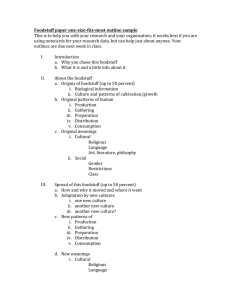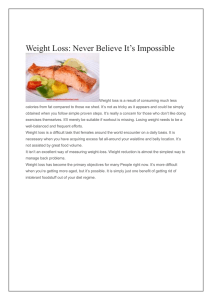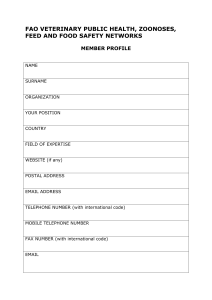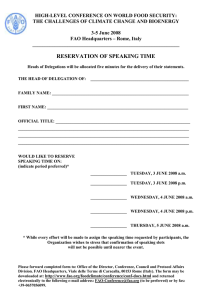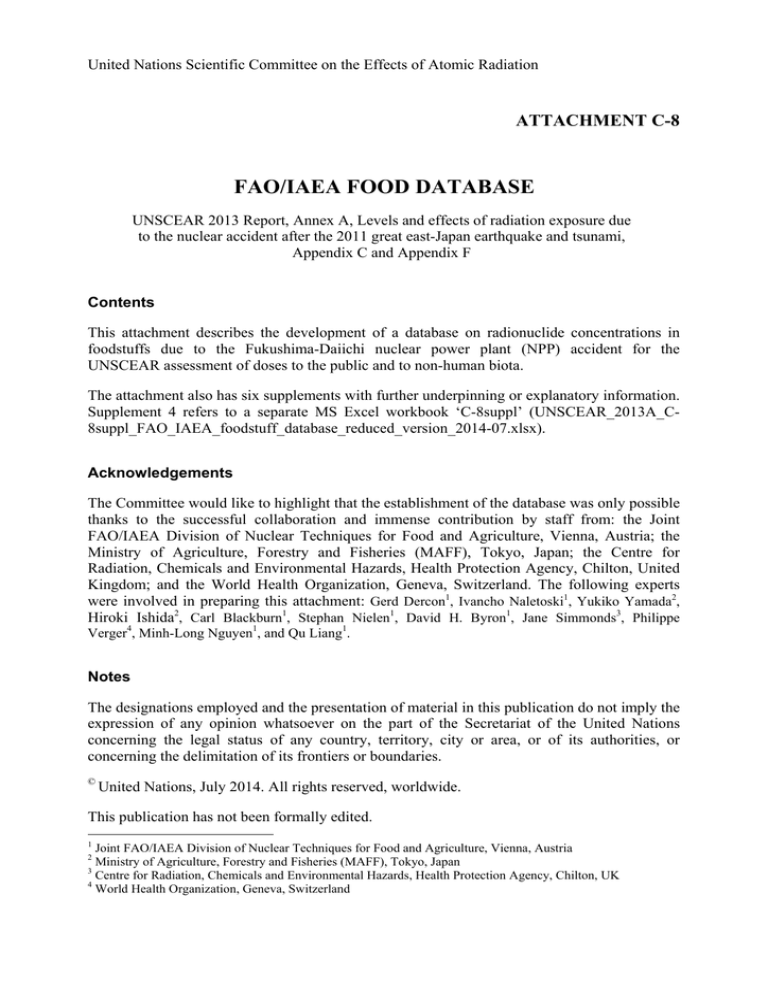
United Nations Scientific Committee on the Effects of Atomic Radiation
ATTACHMENT C-8
FAO/IAEA FOOD DATABASE
UNSCEAR 2013 Report, Annex A, Levels and effects of radiation exposure due
to the nuclear accident after the 2011 great east-Japan earthquake and tsunami,
Appendix C and Appendix F
Contents
This attachment describes the development of a database on radionuclide concentrations in
foodstuffs due to the Fukushima-Daiichi nuclear power plant (NPP) accident for the
UNSCEAR assessment of doses to the public and to non-human biota.
The attachment also has six supplements with further underpinning or explanatory information.
Supplement 4 refers to a separate MS Excel workbook ‘C-8suppl’ (UNSCEAR_2013A_C8suppl_FAO_IAEA_foodstuff_database_reduced_version_2014-07.xlsx).
Acknowledgements
The Committee would like to highlight that the establishment of the database was only possible
thanks to the successful collaboration and immense contribution by staff from: the Joint
FAO/IAEA Division of Nuclear Techniques for Food and Agriculture, Vienna, Austria; the
Ministry of Agriculture, Forestry and Fisheries (MAFF), Tokyo, Japan; the Centre for
Radiation, Chemicals and Environmental Hazards, Health Protection Agency, Chilton, United
Kingdom; and the World Health Organization, Geneva, Switzerland. The following experts
were involved in preparing this attachment: Gerd Dercon1, Ivancho Naletoski1, Yukiko Yamada2,
Hiroki Ishida2, Carl Blackburn1, Stephan Nielen1, David H. Byron1, Jane Simmonds3, Philippe
Verger4, Minh-Long Nguyen1, and Qu Liang1.
Notes
The designations employed and the presentation of material in this publication do not imply the
expression of any opinion whatsoever on the part of the Secretariat of the United Nations
concerning the legal status of any country, territory, city or area, or of its authorities, or
concerning the delimitation of its frontiers or boundaries.
©
United Nations, July 2014. All rights reserved, worldwide.
This publication has not been formally edited.
1
Joint FAO/IAEA Division of Nuclear Techniques for Food and Agriculture, Vienna, Austria
Ministry of Agriculture, Forestry and Fisheries (MAFF), Tokyo, Japan
3
Centre for Radiation, Chemicals and Environmental Hazards, Health Protection Agency, Chilton, UK
4
World Health Organization, Geneva, Switzerland
2
ATTACHMENT C-8: FAO/IAEA FOOD DATABASE
I.
3
BACKGROUND
During the accident at the Fukushima-Daiichi Nuclear Power Station (FDNPS), which started
on 11 March 2011, radionuclides were released into the environment over a protracted period
of time. Radioactive caesium and iodine were observed in soil and plants as early as
15 March. In response to this situation, the Japanese authorities established provisional
regulation values for food on 17 March 2011. A food monitoring programme began
immediately thereafter, and the first restrictions on the distribution of specific products were
imposed and reported by the Japanese Government on 21 March, i.e. as soon as further
sampling had identified the locations and food products that should be removed from the diet.
Over subsequent months, many and various foodstuffs were affected as radionuclides
transferred through the air, rivers, streams and ocean currents, and dispersed into the
environment and into different types of food products at different rates. Within a few months,
concentrations of radioactive iodine were no longer a food safety concern because the specific
isotope of concern, iodine-131, has a short half-life of 8 days and much of it was eliminated
by radioactive decay. However, two radioactive isotopes of caesium were of concern,
caesium-134 and caesium-137, which have half-lives of about 2 and 30 years respectively,
and persist in the environment. Raw milk, vegetables, mushrooms, fruit, nuts, seaweeds,
marine invertebrates, coastal fish, freshwater fish, cattle meat, wild animal meat, brown rice,
wheat, tea leaves and other foodstuffs were found with concentrations of radioactive caesium
above the provisional regulation values and the subsequent limits established by the Japanese
authorities.
II.
DATABASE DEVELOPMENT FOR THE UNSCEAR EVALUATION
From March 2011, a database was compiled on radionuclide concentrations in foodstuffs due
to the FDNPS accident. The database was developed under the guidance of FAO/IAEA and in
collaboration with the Japanese authorities, including the Ministry of Agriculture, Forestry
and Fisheries (MAFF).
The database includes data for over 500 types of foodstuffs sampled in all 47 prefectures of
Japan. These data were provided through the FAO/WHO International Food Safety
Authorities Network (INFOSAN) based on information published and provided by the
Japanese Ministry of Health, Labour and Welfare (MHLW), and were compiled by the Joint
FAO/IAEA Division of Nuclear Techniques in Food and Agriculture.
The database was used in the UNSCEAR assessment of doses to the public and non-human
biota. Approximately 126,000 records on food monitoring were compiled from samples
collected during the period 15 March 2011 through 15 March 2012. In September 2012, these
data were made available — through a relational database prepared in Microsoft Access®
format (hereinafter referred to as the Fukushima Foodstuff Database) — to the relevant expert
subgroups of UNSCEAR who were assessing ingested doses to the population of Japan
resulting from the FDNPS accident.
3
4
ATTACHMENT C-8: FAO/IAEA FOOD DATABASE
A.
Structure of Fukushima Foodstuff Database
The Fukushima Foodstuff Database refers to a set of data related to concentrations of
radionuclides (specifically caesium-134, caesium-137 and iodine-131) in foodstuffs collected
officially in Japan over one-year period after March 2011, along with the tools needed to
utilize and assess the data, such as sorting, extracting, or summarizing.
The database is composed of multiple tables, which are lists of related information presented
in a column/row format. Each row is referred to as a Record. Each foodstuff sample is such a
record. Each column in a table is a category of information referred to as a Field, for instance
radionuclide concentration. One data item, such as the concentration of radionuclides in one
foodstuff sample, is called a Data Value.
The foodstuff database is a relational database, a step further than a flat file database. A
simple spreadsheet (e.g. a Microsoft Excel® worksheet), would be considered a flat file
database. In such a flat file database, relational data must be repeated. For instance, for
information on foodstuff type, the foodstuff name and its taxonomy would need to be
repeated on several records, or for a location, its prefecture and geographic coordinates. Such
repetition of data values, particularly in a database with approximately 126,000 data records
of foodstuff samples, could cause challenges in sorting or processing the compiled
information. Spelling differences in names of locations or synonyms for a foodstuff type
would affect the database's integrity, and, for example, not allow correct calculation of
average values of radionuclide concentrations for that particular location or foodstuff.
To avoid these problems, a relational database was developed, which comprises multiple
tables, each pertaining to a specific topic. For instance, a specific table of locations or
foodstuffs avoids duplication or spelling differences and in the main table with the data
values, each location or foodstuff is identified by numbers, and each number is a unique
identifier for a location or foodstuff.
The Fukushima Foodstuff Database is composed of the following tables:
(i)
Main table (in which all data values are stored)
In this main table (identified by a red rectangle in Fig. 1), radionuclide concentration data are
stored for all foodstuff samples (whether or not they are available for food consumption), in
combination with essential information about (a) the date of sampling, date of obtaining the
analytical results and press release date, (b) origin of the samples (location and prefecture,
through unique IDs), (c) name and taxonomy of the food product (unique ID), (d) availability
for food consumption, (e) pre- or post-market sampling; (f) additional information about
foodstuff samples, such as the cultivation/harvest characteristics (e.g. indoor versus outdoor
cultivation); (g) type of detectors used to measure the radionuclides in the samples; (h)
foodstuff categories (developed by UNSCEAR expert subgroups, using unique IDs; see below
for more information); (i) Japanese foodstuff categories (through unique IDs); (j) samples
from wildlife, and (k) status of the product (processed versus not processed).
(ii)
Location table
(iii) Prefecture table
(iv)
Foodstuff product table
(v)
UNSCEAR expert subgroup C2 (Foodstuffs) categories and subcategories
ATTACHMENT C-8: FAO/IAEA FOOD DATABASE
(vi)
(vii)
5
UNSCEAR expert subgroup C3 (Wild versus domesticated species) categories and
subcategories
Japanese foodstuff categories
Figure 1 shows the structure of the relational database and how the different tables were
linked.
Figure 1: Structure of relational Fukushima Foodstuff Database (red rectangle indicates the
main table)
In the relational database, categorical variables (i.e. variables that can take on one of a limited,
and usually fixed, number of possible values) were used in the following main fields:
(viii) UNSCEAR expert subgroup C2 categories and subcategories for the foodstuff
samples (Assessment of doses to the public, see categories under supplement 1)
(ix)
UNSCEAR expert subgroup C3 categories for the foodstuff samples (Assessment
of doses to non-human biota, see categories under supplement 2)
(x)
Japanese food categories
(xi)
Availability for food consumption
5
6
ATTACHMENT C-8: FAO/IAEA FOOD DATABASE
The variables reflecting the UNSCEAR expert subgroup C2 and C3 categories and the
availability for food consumption were essential variables used in the UNSCEAR assessment
of doses to the public and to non-human biota. The C2 and C3 categories were established in
close collaboration with the respective UNSCEAR Lead Writers.
Japanese food categories were included in the database for information only.
More information about the levels of the above mentioned categorical variables (availability
for food consumption and Japanese food categories) can be found in supplement 3.
B.
Simplification of database
Date for calculation of the number of months after the accident
In the foodstuff database, only samples collected between 15 March 2011 and 15 March 2012
were included. Data on foodstuff samples collected in the first year, but reported later, were
excluded from the database.
For simplification, all foodstuffs were classified according to the number of months after the
accident. For example, number “1” indicates that sampling was conducted in the period from
15 March 2011 to 14 April 2011.
In general, “Date of Sampling” was used to calculate “Months after Accident”. If it was
unknown, “Date of obtaining Data” was used. If both “Date of Sampling” and “Date of
obtaining Data” were not known, “Date of Press Release” was used.
Availability for food consumption
For purposes of the UNSCEAR assessment, some categorical variables were simplified. For
example, the original variable indicating the availability of food for consumption had multiple
levels as indicated in supplement 3. This variable was changed to have only two levels, i.e.
available or not available for consumption. For the calculation of dose, only samples that
represented foodstuffs available for consumption were used.
Radionuclide concentrations
For all data with caesium-134 and caesium-137 concentrations in foodstuffs that were below
the detection limit of the detectors, a value of 10 Bq/kg was assigned. A similar value was
used for data on iodine-131 concentrations, except for those samples collected five or more
months after the accident. For these latter data, a value of 0 Bq/kg was assigned.
If only the sum of caesium-134 and caesium-137 concentrations was provided, the decay of
caesium-134 and caesium-137 for each two-month period was taken into consideration when
calculating the activity concentration of caesium-134 and caesium-137 respectively.
Table 1 shows the ratio of caesium-134 and caesium-137 to the total radioactive caesium used
for calculation. The concentration of caesium-134 and caesium-137 in air was almost the
same. Most of the ratios of caesium-134 to caesium-137 were found to be between 0.9 and 1.1
ATTACHMENT C-8: FAO/IAEA FOOD DATABASE
7
(Ohkura, et al, 2012) 5. In March 2012, the report of a research project was issued jointly by
the Ministry of Education, Culture, Sports, Science and Technology (MEXT) and MAFF,
which stated that from the analytical results of soil samples, the average ratio of caesium-134
and caesium-137 on 14 June 2011 was 0.92:1. This ratio on that specific day was used to
estimate the ratio of these two radionuclides in specific periods. Also using this value, the
ratio at the time of emission was calculated to be 1 to 1.
Table 1: Ratio of caesium-134 and caesium-137 to total radioactive caesium (calculated by
MAFF)
Month after accident
Ratio of caesium-134
Ratio of caesium-137
1 or 2
0.50
0.50
3 or 4
0.49
0.51
5 or 6
0.47
0.53
7 or 8
0.46
0.54
9 or 10
0.45
0.55
11 or 12
0.44
0.56
C.
Final selection of dataset for UNSCEAR assessment
For the UNSCEAR assessment for both expert subgroups C2 and C3, all relevant variables
were identified in close collaboration with the Lead Writers (expert subgroup leaders),
selected from the relational database (via an MS Access Query), and exported in one flat file
worksheet (MS Excel). The final selection of variables used can be found in Table 2.
In the resulting worksheet, pivot tables were created for further rapid selection of datasets
based on foodstuff categories or locations. Such pivot tables are useful to summarize, analyse,
explore, and present summary data and can help visualize summary data so that comparisons,
patterns, and trends can easily be seen.
Table 2: Variables selected in the UNSCEAR assessment for expert subgroups C2 and C3
Column heading
Run_ID
Orig_Index_No
Description
Unique index number assigned by the Joint FAO/IAEA Division
The order number of the sample within each individual press release by MHLW
Serial_No
Unique serial number assigned by the MAFF of Japan
Prefecture
Prefecture name
Location
Location name
LocSpecifier
Latitude
Specifier for the location of sampling
Latitude in degrees
5
Okura, Takehisa; Oishi, Tetsuya; Taki, Mitsumasa; Shibanuma, Yukio; Kikuchi, Masamitsu; Akino, Hitoshi;
Kikuta, Yasuaki; Kawasaki, Masatsugu; Saegusa, Jun; Tsutsumi, Masahiro; Ogose, Hitoshi; Tamura, Shunsuke;
Sawahata, Tadahiro, 2012. Emergency monitoring of environmental radiation and atmospheric radionuclides at
Nuclear Science Research Institute, JAEA following the accident of Fukushima Daiichi Nuclear Power Plant.
Report No. : JAEA-Data/Code 2012-010, 37 Pages, PDF : JAEA-Data-Code-2012-010.pdf:2.28MB.
7
8
ATTACHMENT C-8: FAO/IAEA FOOD DATABASE
Column heading
Longitude
Food
Description
Longitude in degrees
Name of the food product
FoodSpecifier
FoodLatin
Origin_Type
Post_Pre_Market
Detector
Specifier for the food product (for example: Boiled, roasted…)
Latin name of the food product
Additional information about foodstuff sample such as the cultivation/harvest characteristics (for
example: outdoor, indoor, offshore …)
Sampling timing (Pre- or post- market)
Type of the detector
AFC_Cat
Availability for food consumption - Japanese category
Date_f_calc_MOA
Sampling_F
Sampling_L
Data_Obt
Date for calculation of the number of months after the accident
Date of first sampling
Date of last sampling
Date of obtaining the analytical results
PRD
Press release date
AFC_YN
Availability for food consumption - (yes or no), based on the Japanese categories (field AFC_Cat)
I_131_FAO
Corrected numeric value of the iodine-131 concentration in food products
Cs_134_FAO
Corrected numeric value of the caesium-134 concentration in food products
Cs_137_FAO
Corrected numeric value of the caesium-137 concentration in food products
Cs_Tot_FAO
Corrected numeric value of the total radio-caesium concentration in food products
JP_Small
Japanese food product category (small)
JP_Medium
JP_Large
Japanese food product category (medium)
Japanese food product category (large)
Codex_Code
FAO_Proc-NonProc
C2_Subcategory
C2_Category
C3_Subcategory
C3_Category
Codex Alimentarius code (only for vegetables)
Status of the food product (Processed or not processed)
UNSCEAR expert subgroup C2 subcategory
UNSCEAR expert subgroup C2 category
UNSCEAR expert subgroup C3 subcategory
UNSCEAR expert subgroup C3 category
An extract of the main table of the database has been made in Microsoft Excel® (for all
foodstuff samples used in the UNSCEAR assessment) and is available in digital format as
another attachment (C-8suppl) to this report on the Food database.
III. METADATA ANALYSIS OF THE DATABASE
A set of tables and figures below indicate the main characteristics of the data, and also shows
the trend of data availability in time over the first year after the accident.
Figure 2 indicates the number of collected samples for the period of one year (15 March
2011–15 March 2012) after the accident. The first 5,000 samples were collected at the end of
the third month, the first 25,000 samples close to the 6th month, approximately 60,000
samples around the 8th month, and the milestone of 100,,000 samples was reached between
month 10 and 11.
ATTACHMENT C-8: FAO/IAEA FOOD DATABASE
9
Figure 2: Accumulated numbers of foodstuff samples collected from 15 March 2011 until
15 March 2012
Figure 3 shows the geographic distribution of the foodstuff samples. At three months after the
accident, 63% of the collected samples (3,381 samples) came from Fukushima Prefecture and
18% (982 samples) from Ibaraki Prefecture (located to the south of Fukushima Prefecture). At
12 months after the accident (i.e. as of 15 March 2012), over 16% of the total number of
samples (20,621 samples) had been collected in Fukushima Prefecture. Approximately 50%
of the samples (around 61,500 samples) came from neighbouring prefectures.
Figure 3: Geographic distribution (prefecture level) of the foodstuff samples collected across
47 prefectures (15 March 2011–15 March 2012)
9
10
ATTACHMENT C-8: FAO/IAEA FOOD DATABASE
Table 3 also shows the major emphasis on the sampling of cattle meat: representing 66.9% of
the samples. Vegetables represented approximately 10% of the foodstuff samples. Marine fish
and migratory fish accounted for close to 5% of the samples, whereas rice and rice products
about 3%.
Table 3: Distribution of foodstuff samples across expert subgroup C2 categories (15 March
2011 – 15 March 2012)
C2_Category
Algae
Cereals
Eggs
C2_Subcategory
Totals
%Total
Algae
319
0.25
Other cereals
507
0.40
Rice and rice products (excl oil)
4010
3.19
Wheat and wheat products
345
0.27
Poultry eggs
453
0.36
Food of mixed composition
Food of mixed composition
58
0.05
Freshwater fish and shellfish
Crustaceans (freshwater)
11
0.01
Fruits
Marine species (e.g. Fish and Shellfish)
Meat
Milk and dairy products
Freshwater fish
820
0.65
Molluscs (freshwater)
4
0.00
Fresh and processed fruits
3512
2.79
Juices
63
0.05
Crustaceans (marine)
159
0.13
Marine fish and migratory fish
6218
4.94
Molluscs (marine)
956
0.76
Other marine species
99
0.08
Cattle meat
84189
66.91
Other meat
550
0.44
Pork meat (excl wild boar)
542
0.43
Poultry
223
0.18
Milk
2493
1.98
Other dairy products
289
0.23
Mushrooms
Mushrooms
2789
2.22
Other plants
Other plants
1357
1.08
Unclassified
Unclassified product
3157
2.51
Vegetables
Leafy vegetables
3498
2.78
Other vegetables
6157
4.89
Root vegetables
3048
2.42
Considering single food products and not categories, the ranking was slightly different from
the second position downwards, with rice (3.2%), cattle milk (2.0%), Japanese green tea
leaves (1.8%), shiitake mushrooms (1.3%) and spinach (1.2%) (Table 4).
ATTACHMENT C-8: FAO/IAEA FOOD DATABASE
11
Table 4: Top ten ranking of foodstuff types in descending order of sample share (absolute
values and percentage of total number of samples over the first year after the accident)
Food
Total
% Total
Cattle meat
84188
66.9
Rice
3984
3.2
Cattle milk
2493
2.0
Japanese green tea leaves
2235
1.8
Shiitake (mushroom)
1578
1.3
Spinach
1509
1.2
Soybean
685
0.5
Cucumber
675
0.5
Apple
663
0.5
Japanese mustard spinach (Komatsuna)
Others (645 foodstuff types)
640
0.5
27171
21.6
As expected, the sampling focused mainly on products collected from agricultural land or
aquaculture, with close to 93% of the samples. Only 7 % of the samples were related to
foodstuffs such as marine or freshwater fish, game meat or wild mushrooms (Table 5).
Table 5: Distribution of foodstuff samples across expert subgroup C3 categories (15 March
2011–15 March 2012)
C3_Category
Brackish ecosystems
Freshwater ecosystems
Marine ecosystems
Others
Terrestrial ecosystems
Unclassified
C3_Subcategory
Total
% Total
Brackish wild
34
0.027
Freshwater aquaculture
222
0.1764
Freshwater wild
608
0.4832
Marine aquaculture
154
0.1224
Marine wild
7228
5.7444
Others
7179
5.7055
Cultivated mushrooms
2290
1.82
Cultivated plants or crops
21701
17.247
Domesticated animals
84945
67.51
Unclassified mushrooms
15
0.0119
Wild animals
528
0.4196
Wild mushrooms
412
0.3274
Wild plants
258
0.205
Unclassified
252
0.2003
More detailed information about the time distribution of the samples for the different expert
subgroup C2 and C3 categories can be found in supplements 5 and 6.
IV. CONCLUSIONS
The compilation and organization of measurement data into the foodstuff database was
essential for the Committee to conduct its assessment of doses to the public and to non-human
11
12
ATTACHMENT C-8: FAO/IAEA FOOD DATABASE
biota. Approximately 126,000 records on food monitoring were compiled for the sampling
period of 15 March 2011–15 March 2012.
The establishment of a relational database facilitated rapid data analysis by the UNSCEAR
experts for the Committee.
Besides its application in the current UNSCEAR evaluation, the relational database is
expected to be a valuable resource for scientists in the future for assessing the long-term
impact of the accident. In this context, further uploading of all collected foodstuff data to the
database over the coming years would be beneficial. As at 13 December 2012, approximately
330,000 records of foodstuffs were available.
ATTACHMENT C-8: FAO/IAEA FOOD DATABASE
13
Supplementary material
Supplement 1:
Categories and subcategories of foodstuff samples used under UNSCEAR expert subgroup
C2 (sub) categories for the assessment of doses to the public.
C2_Category
Algae
Cereals
C2_Subcategory
Algae
Other cereals
Rice and rice products (excl oil)
Wheat and wheat products
Eggs
Poultry eggs
Food of mixed composition
Food of mixed composition
Freshwater fish and shellfish
Crustaceans (freshwater)
Freshwater fish
Molluscs (freshwater)
Fruits
Fresh and processed fruits
Juices
Marine species (e.g. Fish and Shellfish)
Crustaceans (marine)
Marine fish and migratory fish
Molluscs (marine)
Other marine species
Meat
Cattle meat
Other meat
Pork meat (excl wild boar)
Poultry
Milk and dairy products
Milk
Other dairy products
Mushrooms
Mushrooms
Other plants
Other plants
Unclassified
Unclassified product
Vegetables
Leafy vegetables
Other vegetables
Root vegetables
13
14
ATTACHMENT C-8: FAO/IAEA FOOD DATABASE
Supplement 2:
Categories and subcategories of foodstuff samples used under UNSCEAR expert subgroup
C3 (sub) categories for assessing doses to non-human biota.
C3_Category
Brackish ecosystems
Freshwater ecosystems
C3_Subcategory
Brackish wild
Freshwater aquaculture
Freshwater wild
Marine ecosystems
Marine aquaculture
Marine wild
Others
Terrestrial ecosystems
Others
Cultivated mushrooms
Cultivated plants or crops
Domesticated animals
Unclassified mushrooms
Wild animals
Wild mushrooms
Wild plants
Unclassified
Unclassified
ATTACHMENT C-8: FAO/IAEA FOOD DATABASE
15
Supplement 3:
Description of specific categorical variables “Availability for food consumption” and
“Japanese food categories”
a. Availability for food consumption (AFC) category
In order to clarify whether foodstuffs in the same lot are available for consumption or not,
eight categories were created according to the time of sampling; and whether the foodstuff
was: subject to “distribution restraints imposed by government and local governments on the
sampling date” and sampled in the harvest season. In creating these categories, the file
“Restriction of Distribution” is used as reference. Table 1 indicates characteristics of each
category.
Table S3.1: Characteristics of each AFC category
Category
Sampling pre-market or
post-market
0
Pre-market
1
Pre-market
2
3
Pre-market
Pre-market
4
Pre-market
5
Pre-market
Was distribution restraint
imposed on the sampling
date?
No
Sampled before
distribution restraints
No
Sampled before
distribution restraints
Yes
Yes
But the result was
disclosed within the day
before lifting restraints
No
Sampled after lifting
restraints
No
6
M
Pre-market
Post-market
Yes or No
No
Was foodstuff
sampled in harvest
season?
No
Sampled before
harvest season*1.
Yes
Yes or No
Yes or No
Was foodstuff available for
consumption?
No
Yes
Yes
No
Yes
(Possibility that foodstuff
was distributed after lifting
restraints.)
Yes
Yes
Yes
No*2
Yes
No
Yes
*1. Raw milk sampled during the cessation of milk production by the destruction of dairy factories and/or milk collection centre with
cooling facility was included.
*2. Fishing was banned on the sampling date. Crops in AFC category 6 were cultivated only in some experimental farms
15
16
ATTACHMENT C-8: FAO/IAEA FOOD DATABASE
b. Food class (National Health and Nutrition Survey in Japan)
In the National Health and Nutrition Survey in Japan, there were 17 large classes that are
further sub-divided into 99 smaller classes originally for the purpose of determining the
nutritional status of citizens.
Food class 100 and 200 were additionally established because there were some foodstuffs
falling outside existing classes.
- Food class 100 includes foodstuffs which are normally eaten after processing or
cooking whereby radionuclide concentration is reduced, e.g. dried mushrooms and
dried wheat noodles.
- Food class 200 includes mineral water, processed foods of multiple ingredients,
and those foods without sufficient information for classification.
For aquatic food samples, excluding processed foods of multiple ingredients, “Marine or fresh
water” was added in the data sheet. Eight categories were created according to the “habitat”
and “in the case of migrating species, place of sampling”. Characteristics of each category
were described as follows in table 2:
Table 2: Characteristics of each category of “Marine or fresh water”
Category
The habitat
In the case of migrating species, place of sampling
F
Fresh water
-
B
Brackish water
-
M
MB
A(F)*
Marine water
-
Mostly in marine water (occasionally in brackish water)
-
Migrating between fresh water and marine water
Fresh water
A(B)*
Brackish water
A(M)*
X
Marine water
Insufficient information
* Letter in parentheses indicates place of sampling.
Foodstuff sampled in either marine wildlife or terrestrial wildlife was identified as “1” in the
“WL” field in the database.
ATTACHMENT C-8: FAO/IAEA FOOD DATABASE
17
Supplement 4:
Extract of the main table of the database, in Microsoft Excel format, for all foodstuff samples
used in the UNSCEAR assessment, is available in digital format. See attachment ‘C-8suppl’
(UNSCEAR_2013A_C-8suppl_FAO_IAEA_foodstuff_database_reduced_version_201407.xlsx).
17
18
Supplement 5:
Number of foodstuff samples under UNSCEAR expert subgroup C2 (sub) categories, collected from 15 March 2011 until 15 March 2012 (Number
in columns reflects the number of months after the accident)
C2_Category
1
2
3
5
3
20
4
5
16
11
2
64
14
1
6
10
18
88
82
14
2
9
1
26
15
241
96
37
1
621
344
8
6
7
8
78
22
16
84
61
153
28
19
6
1 731
15
45
16
132
1 948
8
25
1
102
2
99
70
1
89
2
56
44
115
219
417
604
4
140
20
1
25
4
19
4
173
49
14
18
3
16
7
149
8
36
21
171
481
565
71
3
270
48
16
88
1
25
12
140
11
29
16
185
243
660
219
12
271
57
13
2 865
5
43
10
133
29
107
15
167
64
763
99
14
481
86
14
6 060
63
57
22
194
9
242
100
106
90
678
177
577
4
20
742
88
7
8 402
91
55
11
196
35
527
173
1 579
128
448
390
131
5
159
29
72
548
385
60
9
10
43
53
33
151
40
2
107
54
24
20
31
8
44
60
34
8
8
5
1
50
61
17
2
536
430
185
15
15
7
22
17
10
1 054
783
448
116
116
63
5
7
3
13 419 18 849 10 574
87
117
64
57
64
35
36
29
18
226
258
217
16
73
17
514
297
170
455
352
55
379
160
116
293
300
154
575
558
271
565
514
239
11
48
8
52
22
81
16
1
63
2
205
16
27
1 010
178
12
13 371
91
76
31
337
58
385
52
114
301
511
384
12
65
9
33
9
74
21
3
185
92
6
26
764
121
5
10 509
23
69
32
271
28
227
52
107
275
399
322
Grand Total: Total
% Total
319
0.3%
507
0.4%
4 010
3.2%
345
0.3%
453
0.4%
58
0.0%
11
0.0%
820
0.7%
4
0.0%
3 512
2.8%
63
0.1%
159
0.1%
6 218
4.9%
956
0.8%
99
0.1%
84 189
66.9%
550
0.4%
542
0.4%
223
0.2%
2 493
2.0%
289
0.2%
2 789
2.2%
1 357
1.1%
3 157
2.5%
3 498
2.8%
6 157
4.9%
3 048
2.4%
125 826
100.0%
ATTACHMENT C-8: FAO/IAEA FOOD DATABASE
C2_Subcategory
Algae
Other cereals
Rice and rice products (excl oil)
Wheat and wheat products
Eggs
Poultry eggs
Food of mixed composition
Food of mixed composition
Freshwater fish and shellfish
Crustaceans (freshwater)
Freshwater fish
Molluscs (freshwater)
Fruits
Fresh and processed fruits
Juices
Marine species (e.g. Fish and Shellfish) Crustaceans (Marine)
Marine fish and migratory fish
Molluscs (marine)
Other marine species
Meat
Beef / cattle
Other meat
Pork meat (excl wild boar)
Poultry
Milk and dairy products
Milk
Other dairy products
Mushrooms
Mushrooms
Other plants
Other plants
Unclassified
Unclassified product
Vegetables
Leafy vegetables
Other vegetables
Root vegetables
Algae
Cereals
Supplement 6:
Number of foodstuff samples, under UNSCEAR expert subgroup C3 (sub) categories, collected from 15 March 2011 until 15 March 2012 (Number
in columns reflects the number of months after the accident)
1
2
1
3
4
10
2
2
16
2
23
80
101
263
96
1 078
51
146
201
157
1 021
44
233
275
36
1 227
41
3
18
2
4
2
53
33
72
46
5
6
3
25
78
3
320
271
28
1 562
124
2
21
49
6
339
243
91
1 787
2 921
1
1
24
12
2
16
5
3
13
73
6
582
385
142
3 384
6 143
4
59
96
11
2
7
8
9
10
11
12
3
2
2
2
5
7
23
10
30
39
22
14
37
39
36
8
33
149
8
32
32
22
24
21
830 1 155
895
519 1 196
912
519
851
648
1 896
833
794
311
402
267
167
372
221
3 774 2 611 2 072
816 1 317 1 052
8 471 13 514 18 938 10 626 13 466 10 606
7
4
87
84
115
63
88
22
202
83
6
5
1
4
1
19
9
33
14
8
26
43
8
32
35
Grand total:
Total
% Total
34
0.0%
222
0.2%
608
0.5%
154
0.1%
7 228
5.7%
7 179
5.7%
2 290
1.8%
21 701
17.2%
84 945
67.5%
15
0.0%
528
0.4%
412
0.3%
258
0.2%
252
0.2%
125 826
100.0%
ATTACHMENT C-8: FAO/IAEA FOOD DATABASE
C3_Category
C3_Subcategory
Brackish ecosystems
Brackish wild
Freshwater ecosystems Freshwater aquaculture
Freshwater wild
Marine ecosystems
Marine aquaculture
Marine wild
Others
Others
Terrestrial ecosystems Cultivated mushrooms
Cultivated plants or crops
Domesticated animals
Unclassified mushrooms
Wild animals
Wild mushrooms
Wild plants
Unclassified
Unclassified
19
20
ATTACHMENT C-8: FAO/IAEA FOOD DATABASE

